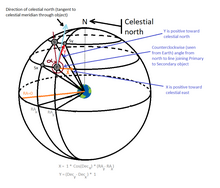
Back JPL Horizons On-Line Ephemeris System Catalan JPL Horizons On-Line Ephemeris System French JPL Horizons On-Line Ephemeris System Japanese JPL Horizons On-Line Ephemeris System NB 噴氣推進實驗室線上曆書系統 Chinese

JPL Horizons On-Line Ephemeris System provides access to key Solar System data and flexible production of highly accurate ephemerides for Solar System objects.
Osculating elements at a given epoch (such as produced by the JPL Small-Body Database) are always an approximation to an object's orbit (i.e. an unperturbed conic orbit or a "two-body" orbit). The real orbit (or the best approximation to such) considers perturbations by all planets, a few of the larger asteroids, a few other usually small physical forces, and requires numerical integration.
Jet Propulsion Laboratory (JPL) ephemerides do not use things such as periods, eccentricities, etc.[2] Instead, JPL integrates the equations of motion in Cartesian coordinates (x,y,z), and adjusts the initial conditions in order to fit modern, highly accurate measurements of planetary positions.[2]
Since August 2013, Horizons has been using ephemeris DE431.[3] During the week of 12 April 2021, the Horizons ephemeris system was updated to replace the DE430/431 planetary ephemeris, used since 2013, with the new DE440/441 solution. The new DE440/441 general-purpose planetary solution includes seven additional years of ground and space-based astrometric data, data calibrations, and dynamical model improvements, most significantly involving Jupiter, Saturn, Pluto, and the Kuiper Belt. Inclusion of 30 new Kuiper-belt masses, and the Kuiper Belt ring mass, results in a time-varying shift of ~100 km in DE441's barycenter relative to DE431.
In September 2021 JPL started transitioning from common gateway interface (CGI) to application programming interface (API).
- ^ "Cercansi collaboratori per interfaccia grafica NASA Horizons". 28 October 2019.
- ^ a b Alan B. Chamberlin (2006-02-28). "Frequently Asked Questions (FAQ): What's the exact value of..." JPL Solar System Dynamics. Retrieved 2011-01-20.
- ^ Jet Propulsion Laboratory (August 28, 2015). "HORIZONS User Manual". "Long term ephemeridies" section. Retrieved January 10, 2016.
© MMXXIII Rich X Search. We shall prevail. All rights reserved. Rich X Search